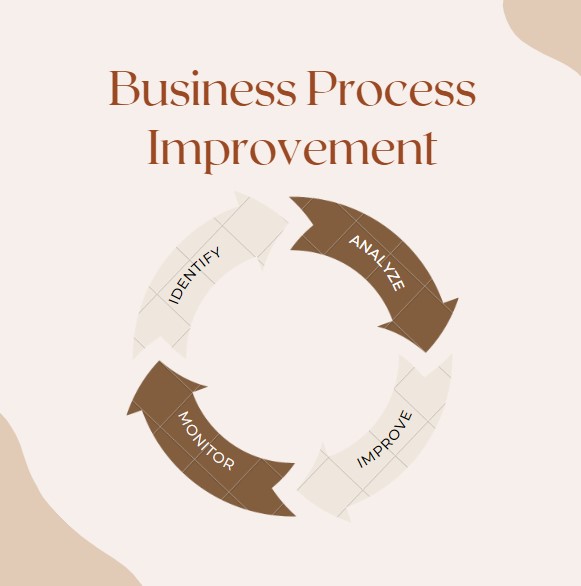
No matter what industry your business is involved in, process improvement is an essential practice if you want to stay ahead of your competition. It’s also necessary to enable your organization to make workflows more efficient, cost-effective, and customer-focused.
Besides offering you a competitive edge, continuous process improvement also allows you to deliver better results to your customers over time and meet their demands. But what else does process improvement involve? Let’s take a closer look…
Understanding Process Improvement
Process improvement is the ongoing practice of identifying, examining, and improving business processes. The purpose of process improvement is to increase your organization’s efficiency and improve the quality of products and services. It’s also necessary for eliminating waste and to reach operational excellence.

Unlike a one-time fix, process improvement is a continuous cycle of assessment and refinement. When you constantly optimize your processes, your business can improve over time and keep its competitive edge. Plus, by revisiting your processes, you can stay responsive to your customers’ needs and market changes, leading to sustained growth in the long run.
The benefits of process improvement
So, why should you implement process improvement initiatives? Here are the main advantages of this practice:
- It lowers your costs and boosts productivity.
- Certain process improvement techniques can reduce errors and defects for more reliable outcomes.
- It can improve the speed and quality of your products or services.
- Process improvements help to increase your adaptability in changing markets.

Process Improvement Methodologies
If you want to improve your business and drive it toward success, you will need to consider which process improvement methodology will work best. Of course, you can incorporate as many or as few methodologies as you’d like and tailor them to suit your organization.
Some of the most commonly used continuous process improvement methodologies include:
Kaizen
Kaizen is all about making small, steady improvements over time. It encourages everyone in your company to look for ways to improve business operations.
Rather than punishing mistakes, Kaizen sees them as chances to learn and improve. Typically, the process involves setting goals, reviewing how things are done, making changes, and then checking to see if those changes worked.
PDCA cycle
The PDCA (Plan, Do, Check, Act) cycle is a repetitive process improvement methodology. It involves four main steps:
- Plan: Identify areas for improvement.
- Do: Implement any necessary changes.
- Check: Measure your results.
- Act: Standardize any successful changes or revisit the plan.
Six Sigma
Six Sigma uses the DMAIC (Define, Measure, Analyze, Improve, Control) approach, which helps reduce defects and variability in your products. Usually, this method relies on data-driven analysis to identify and eliminate errors. In turn, this will improve the quality of your processes.
5S
5S is a workplace organization technique that is aimed at improving productivity by standardizing processes. The five steps include:
- Sort
- Set in order
- Shine
- Standardize
- Sustain
Ultimately, it helps to create clean and efficient working environments. Of course, this is essential for maintaining lean operations.
Total Quality Management (TQM)
TQM is a company-wide approach to improving quality and customer satisfaction. It involves everyone in your organization and emphasizes continuous improvement of your existing processes and the prevention of errors. It’s also great for fostering a company culture where your employees are proactively involved in identifying solutions.
Kanban
Kanban is a method that focuses on process workflow visualization. This can help your team to identify bottlenecks more easily so that they can prioritize their tasks appropriately. This will improve task management overall, as well as transparency and collaboration among your employees.
Theory of Constraints (TOC)
TOC is used to identify bottlenecks that may limit your process efficiency. It involves continuous improvement since there are always constraints to address. As a result, it facilitates ongoing optimization.
TOC typically follows steps to identify, exploit, subordinate, and elevate constraints, which are then re-evaluated.
Lean manufacturing
Lean manufacturing focuses on eliminating waste and optimizing processes to improve efficiency. To do this, you’ll need to evaluate processes involved in the value stream and improve any systems that are suboptimal. Not only does this reduce costs, but it can also boost productivity in your organization.
Value stream mapping
Value stream mapping visualizes your processes from a customer’s perspective, which can help you identify waste and inefficiencies. The goal is to streamline workflows and improve your service delivery by focusing on value-adding activities.
Process Mapping
Process mapping is a practice in which you create detailed diagrams to visualize your workflows. This helps clarify the roles and responsibilities of your employees and standardize procedures to improve your consistency and performance.

How To Identify Areas For Improvement
To find areas within your organization that are in need of improvement, you’ll need to use certain tools. These may include the following to assess your current workflows:
- Process mapping: This involves visually outlining each step to reveal inefficiencies.
- Data analysis: By analyzing data, you can pinpoint any performance gaps you have.
- Employee feedback: This will reveal insights into the daily challenges your workers face – and potential solutions for these challenges
By doing this, you can strive toward process excellence and prepare your business for long-term success.
Implementing Process Improvement
A continual improvement process is simple to implement – as long as you have the right resources and tools at your disposal. Typically, the implementation process involves six important steps, which we have summarized below:
- Identify your objectives: You’ll need to define what you want to achieve with process improvement.
- Map your existing processes: Outlining your existing workflows is important for determining your starting point.
- Identify areas of improvement: In order to make meaningful changes to your processes, you’ll first need to pinpoint the areas that need change. After all, you can’t improve on systems and processes without knowing where your inefficiencies are.
- Select a methodology: For the best results, you’ll need to choose an approach that suits your organization and meets its needs.
- Implement changes: To improve your processes, you must make targeted adjustments. These should be as specific as possible so that there aren’t any missed opportunities for improvement.
- Monitor, measure, and adjust: Lastly, knowing how well your new processes are working is crucial to achieving improvement. You’ll need to have certain key performance indicators (KPIs) in place to track your outcomes and adjust your processes if and when necessary.
Leveraging Technology For Process Improvement
Before you can implement the steps of process improvement, you may want to consider using a workflow automation platform like HighGear. Using this kind of software, you can easily improve your existing processes and generate detailed reports to review the results of your improvement efforts.
HighGear offers extensive tools for enterprise task management that simplify process mapping and workflow automation. This makes it easier to drive continuous improvement without the need for heavy IT involvement.
Our business process management solutions provide you with a solid foundation to boost your efficiency. Plus, our services can also support more complex initiatives, such as deploying new initiatives and building custom integrations.
FAQs
What is the meaning of process improvement?
Process improvement is the practice of finding and fixing problems in business processes or workflows. This includes looking for ways to make things faster, cheaper, and more effective while aligning these processes with your company’s goals.
What are some examples of process improvement?
Some of the most common examples of process improvement include:
- Automating repetitive tasks
- Streamlining approval processes
- Improving resource allocation
- Redesigning your workflows
- Implementing quality checks
What is the main goal of process improvement?
The main goal of process improvements is to make processes faster and more cost-effective. By constantly improving existing business processes, you can boost your productivity, lower costs, and stay ahead of your competitors.
What is the role of process improvement?
The role of process improvement is to find ways to make business processes better. It also helps to foster a company culture of continuous improvement and ensures your business can adapt and scale as needed.
How important is process improvement?
Process improvements are incredibly important for any business that wants to stay competitive within its industry. By improving your processes regularly, your business can stay on top of trends and keep innovating. In fact, it is essential for long-term success.
What is the overall impact of your process improvement?
Generally, process improvement can lead to:
- Better efficiency
- Higher productivity
- Improved product or service quality
- Increased customer satisfaction
What is business process improvement?
Business process improvement (BPI) is a method used to make an organization’s processes more efficient and effective. Typically, it involves employing strategies such as lean manufacturing, Six Sigma, or Kaizen to improve processes.
What is process improvement in healthcare?
In healthcare, process improvement focuses primarily on making healthcare services better and more efficient. This can include improving patient care and administrative tasks.
Final Thoughts
If you’re ready to implement continual improvement processes within your organization, the best way to do that is with a comprehensive platform like HighGear. With HighGear, you can achieve lasting process improvements to ensure your workflows are efficient and adaptable.
So, if you’re ready to get started, then be sure to book a consultation with one of our workflow automation experts today.
